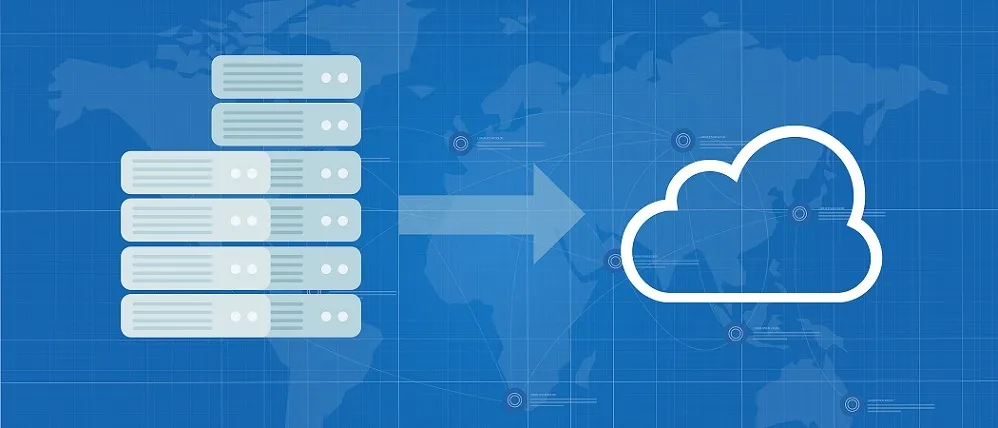A Beginner's Guide To Planning Your Cloud Migration
A Beginner's Guide To Planning Your Cloud Migration
A guide to planning a smooth and successful migration to the cloud, covering key considerations and best practices for beginners. If you're looking at a potential cloud migration the professionals at Blusonic can help.
The cloud has revolutionized the way businesses interact with their customers and manage operations. A successful migration to the cloud can mean a world of difference for companies, transforming them into powerhouses that are built on agility and scalability. For those who wish to embark on this journey, understanding how to plan your cloud migration is essential. This article will be an invaluable guide - a veritable treasure trove of information - for anyone looking to make the switch to the cloud.
Cloud migrations come in all shapes and sizes, so it is important for beginners to understand what makes up a successful strategy. Knowing which steps should be taken first, as well as developing an appropriate timeline based on business needs, are key components of any good migration plan. Additionally, there must be consideration given towards security concerns when making such a move; after all, protecting data from unauthorized access is paramount when dealing with customer information or confidential financial records.
For those who want to take advantage of the benefits that come along with migrating workloads to the cloud but aren’t sure where to start – fear not! This beginner's guide provides useful tips and advice about planning your own cloud migration, allowing you to confidently enter this new era of technology without worry or hesitation.

1. Understand Your Current Infrastructure
Migrating to the cloud is a mammoth task, one that requires significant research and planning. To ensure success in this endeavor, it is essential for businesses to understand their existing infrastructure before beginning any process. This article provides an introductory guide to planning your cloud migration by focusing on understanding current infrastructure.
A thorough assessment of the current set-up should include all components used within the system, such as hardware, software, networking resources, storage capabilities and services. All these elements must be understood thoroughly in order to make informed decisions about which parts are suitable for migrating to the cloud and how they can interact with each other when placed there. Furthermore, examining factors like architecture design choices or scalability requirements will help determine if any adjustments need to be made prior to moving these systems into the cloud environment.
Additionally, assessing cost structures associated with existing expenditure may indicate whether shifting operations onto the cloud could lead to potential savings or increased efficiency. It is important not only to consider the immediate costs but also long-term operational expenses; ensuring that both short-term savings opportunities and future financial benefits are taken into account during the initial migration phase.
In summary then, successfully navigating a move from physical servers towards virtualised environments relies heavily on knowing exactly what needs transferring over first – making sure you have a complete picture of your current setup is key here. By taking time at this stage of your journey you'll be well placed later down the line when deciding which applications become part of your new cloud ecosystem.
2. Analyze Your Current Applications
Analyzing applications is an essential aspect of any cloud migration. Alliteration aside, it helps to assess the current state of your apps before creating a plan for moving them to the cloud. This step involves determining which resources are needed to run each application with optimal performance and what modifications need to be made in order for it to run on the new infrastructure. It also requires that you understand how users will interact with these applications after they have been migrated.
Analytics can help answer many questions related to migrating existing applications. For example, do certain features work better when running in a virtualized environment? Are there compatibility issues between different versions of operating systems or databases? How much load can be handled by the system without compromising performance? What data needs to be transferred over during the transition? Finally, how long will it take for users to become comfortable using the new version of their application?
The answers obtained from this analysis should form the basis for your overall strategy when making the move to the cloud. Knowing exactly what changes need to be made before beginning allows for smoother transitions and cuts down on unexpected costs or delays later on. Considerations must also be taken into account regarding cost efficiency and scalability as well as user experience throughout all stages of app migration planning.
3. Establish Your Migration Goals
The journey of cloud migration can often seem daunting, with a myriad of considerations to take into account. However, the third step towards successful planning is establishing your migration goals; an essential part of any effective plan. To ensure success down the line, it is worth taking time upfront to properly define these objectives.
Having analyzed the current applications in place, this stage involves setting out clear targets for the project which will serve as guiding markers throughout the process. It should be noted that these are likely to evolve over time and require revisiting as different aspects become clearer or more information becomes available. Each goal should also have metrics attached so progress can be tracked and performance evaluated at each juncture.
It is important to consider both short-term and long-term objectives when devising migration goals. While immediate requirements may come first in terms of priority, having longer-term plans in mind allows organizations to leverage their investments more strategically by factoring such aims into current decisions. In this way, companies can maximize returns on investment while also making sure they remain agile enough to stay competitive in ever-changing markets.
4. Research Your Cloud Options
Determining suitable cloud options is a pivotal step in the migration process. It is important to thoroughly research available solutions and their associated benefits for an organization. The process should focus on finding offerings that satisfy specific use cases, support existing workloads and systems of record, as well as remain cost-effective over time.
To begin evaluating potential cloud services, organizations must define criteria such as availability requirements, scalability needs, security protocols, or data privacy regulations. Furthermore, it might be useful to investigate prebuilt architectures and features which can help ease the transition by providing infrastructure templates or automated deployment processes. After narrowing down options based on these factors, more detailed analyses are necessary to determine if certain providers offer better performance than others when it comes to storage speeds or throughput rates.
Organizations also need to consider long term costs alongside short term investments; researching pricing models for various services is essential for this task. For instance, some providers may offer ‘pay per usage’ plans while others prefer subscription-based arrangements where customers pay upfront fees regardless of utilization rate. Thus understanding how different products fit into the company budget becomes crucial before making any decisions regarding migrations.
5. Design Your Cloud Environment
Once an organization has decided to begin the process of migrating to the cloud, it is important that they move onto the next step in their journey: designing a cloud environment. This step involves researching and selecting appropriate services from various providers based on the specific needs and goals of the enterprise. Additionally, organizations must consider how their existing systems will interact with their new cloud infrastructure in order for a successful migration to occur.
When designing a cloud environment, there are several factors that need to be taken into account such as security, scalability, cost-effectiveness, compliance requirements, data storage options and application compatibility. It is essential that these elements are considered when making decisions regarding what type of service or platform should be utilized by an organization during its transition to the cloud. In addition, organizations may want to look into integration strategies that can help make sure all components of their applications work together seamlessly once migrated to the cloud.
Overall, creating an optimal design for a cloud environment is critical for any business looking to migrate its operations successfully. After researching different vendors and services available, it is important for enterprises to identify which ones best fit their individual needs in terms of functionality and budget constraints. Doing this will ensure all necessary measures have been taken prior to beginning the actual migration process.
6. Plan Your Data Migration
Migrating data to the cloud is an essential step in planning a successful cloud migration. It requires careful consideration of the various processes involved, including developing and implementing the right strategy for transferring data securely between systems. With this in mind, it's time to delve deep into what needs to be done when crafting your plan for data migration.
As with any IT project, sound planning is paramount when undertaking a cloud migration. Unpacking all aspects of the data transfer process should commence at the onset, allowing ample time for contingencies and potential issues to be addressed priorly. When designing your plan for migrating data from one system to another, you will need to consider numerous factors such as security protocols, bandwidth capacity and storage requirements. Furthermore, it may also be prudent to investigate how compatible existing applications are with the new environment before making a move.
In order to ensure that migrations run smoothly, organizations must create detailed plans outlining their objectives in terms of timelines and budget constraints. Additionally, they should invest in tools which can help them monitor progress against these goals - automating certain elements while still maintaining manual control over sensitive information transfers where necessary. The ability to analyze performance metrics throughout different stages of deployment can make or break success here; so being able to gauge performance accurately is key if a smooth transition is desired.
7. Test Your Cloud Environment
Testing a cloud environment is an essential part of planning for a successful cloud migration. This process should be undertaken before any data is moved, to ensure that the new environment meets all necessary requirements and performs as expected.
The testing phase involves creating test cases to evaluate various aspects of the cloud environment including functionality, performance and scalability. During this stage it is also important to validate security configurations in order to protect sensitive data from unauthorized access or malicious attacks. It is also advisable to simulate user workloads on the system in order to identify potential bottlenecks or areas where additional resources may be required.
Once all tests have been completed and the cloud environment has passed all criteria, it can then be used for production purposes with confidence that it will perform optimally under real-world conditions. Careful preparation during this step helps minimize disruption and reduce risks associated with migrating mission critical applications and workloads into the cloud.
8. Migrate Your Applications And Data
As businesses increasingly vie for a competitive edge in the digital landscape, cloud migration has become an indispensable part of their strategy. The eighth step in this process is to migrate applications and data from existing infrastructure into the new cloud environment. Before proceeding with this crucial stage of transition, it requires comprehensive planning as well as timely execution.
To ensure successful relocation of applications and data, organizations should deploy systems that are reliable and secure. This can be achieved through proper testing prior to making any alterations or modifications to existing IT setups. Additionally, transforming legacy software applications onto virtualized platforms may require reconfiguration and optimization before they can run optimally on cloud servers. As such, teams should anticipate potential challenges arising from these changes throughout the entire migration process.
It is also essential to create efficient strategies for moving large amounts of data between environments without loss or corruption. Companies should consider leveraging existing tools like replication services for faster movement between clouds and on-premise databases whilst preserving file integrity during transferral operations. Ultimately, formulating meticulous plans and utilizing suitable technologies will facilitate smoother migrations while ensuring minimal disruption to business processes along the way.
Monitor And Manage Your Cloud Environment
Coincidentally, the ninth step in a beginner's guide to planning one's cloud migration is monitoring and managing the cloud environment. This step is essential for ensuring that all applications and data are running successfully on the new platform. It requires careful consideration of which tools are available and how they can be used to monitor performance, manage security and maintain compliance.
The first action when it comes to monitoring and managing your cloud environment is understanding what metrics need to be tracked. Commonly monitored metrics include application response time, system latency, CPU utilization and disk capacity usage. Additionally, you will want to track any changes made within your environment such as configuration updates or software patches. Once these metrics have been identified, appropriate tools must be chosen to collect this data so that it can be properly analyzed.
After selecting the right toolset for capturing data, attention should then turn towards using this information effectively by setting up alerts based on certain criteria that would indicate problems with the system. Alerts might include thresholds being exceeded or services becoming unavailable. By establishing an alerting process early on, potential issues with an organization’s cloud environment can be addressed quickly before they become more troublesome down the line.
In summary, monitoring and managing one's cloud environment is critical during a migration process as it helps ensure successful deployment of applications and data onto a new platform. Knowing which metrics need to be tracked along with choosing suitable tools for collecting and analyzing this data will lay the groundwork for proper oversight of the entire system while also giving organizations insight into problem areas where additional resources may be required if needed.
10. Optimize Your Cloud Environment
The process of cloud migration is often compared to a journey, with its travelers embarking on an uncharted path towards their destination. The tenth step in this expedition requires the optimization of the environment. This involves fine-tuning the servers and services for improved performance and cost savings.
For instance, resources like compute instances should be allocated according to requirements that are regularly reviewed to ensure they remain effective. Additionally, workloads can be scaled up or down depending on usage levels as well as automated based on parameters such as time of day or peak demand periods. Furthermore, selecting appropriate storage solutions can help reduce costs while still meeting specific needs.
The overall aim is to maximize efficiency by reducing waste and ensuring that each component serves its intended purpose. With careful management and monitoring it is possible to achieve optimal utilization which will lead to greater operational effectiveness and increased profitability over time.
Now You're Ready To Do A Cloud Migration
When embarking on a cloud migration journey, it is important to be mindful of the process. Careful planning and research are essential for achieving the desired outcome. As the old adage goes “failing to plan is planning to fail” – this especially applies when migrating applications or data to the cloud.
The first step in any successful cloud migration project is understanding what infrastructure currently exists and how different applications interact with each other. Once that has been established, goals can then be set around which components should move over and why. Research into available options must also take place; matching services offered by providers against individual requirements will ensure an efficient selection process takes place.
Once all these steps have been completed, designing the environment, testing before deployment, migrating both applications and data safely, monitoring performance post-migration and continuing optimization are all key elements required for a successful transition to the cloud. Combined together these steps provide structure throughout the entire process resulting in fewer headaches along the way.
Let Us Help You!
Sign up to our newsletter











